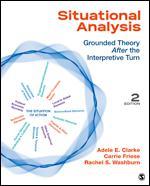Student Resources
About Situational Analysis
Situational Analysis: Grounded Theory After the Interpretive Turn offers an innovative extension of constructivist grounded theory method useful in qualitative research. In Situational Analysis, the situation itself becomes the fundamental unit of analysis. Attention is given not only to humans as individuals and collectivities but also to nonhuman things---materialities from technologies to buildings, animals, media---the natural and unnatural lived environments in which we all dwell. Focus is on relations among all the major elements and how they matter in the situation.
Methodologically grounded in Straussian grounded theory, Situational Analysis thus has roots in pragmatism and interactionism. To engage the dense complexities of situations theoretically, the method also braids together Anselm Strauss's ecological social worlds theory, Michel Foucault’s discourse analytics, Giles Deleuze and Felix Guattari’s rhizomes and assemblages, feminist and social justice approaches. Situational Analysis can be used in qualitative projects centered on interviews, observations, documents and/or visual, narrative and historical discourse materials, including websites.
In doing Situational Analysis, researchers pursue three kinds of maps emphasizing differences and relationality:
- Situational maps lay out all the major human, nonhuman, discursive, institutional and material elements in the research situation of concern, provoking deeply empirical analysis of relations among them;
- Social worlds/arenas maps lay out the collective actors in the situation---groups, organizations, institutions---and their arenas of commitment to action in that situation;
- Positional maps examine the full range of often contested positions taken and not taken on important issues in the situation, including attending to “minor” voices.
Using extensive in-depth examples, co-authors Adele Clarke, Carrie Friese and Rachel Washburn discuss getting started, how to do all of these maps and memo them, the kinds of analytic work they accomplish, and how to write up the results centered on the distinctive strengths of Situational Analysis as a method. The book also offers ambitious chapters on mapping and analyzing narrative, visual, and historical discourse materials with detailed exemplars of each.
Situational Analysis helps researchers examine relationality, silences in data, conditionality, difference and complexity. It is also very useful for multi-site research projects, increasingly common not only in the social sciences but also in the humanities and related professional fields. The book is excellent for advanced undergraduate and graduate-level qualitative research courses, and also supports professional researchers and consultants from diverse backgrounds pursuing qualitative projects.

